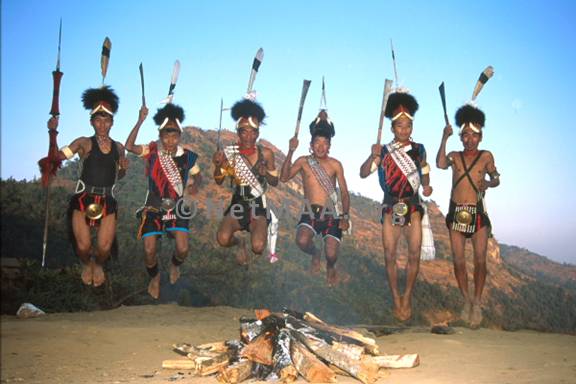DANCING ON THE MOUNTAIN TOP
By: Harry Hpone Thant
Since the emergence of civilizations the Earth has been the provider of both food and shelter for humans. In return, festivals are celebrated annually to thank and return the favors of Mother Earth for the bountiful harvests. These festivals and celebrations are held in many forms by various communities and clans on earth mostly after harvest times.
One of these is the New Year Festival held annually in January by our Naga cousins who live on the high mountain peaks of northwestern Myanmar. Many Naga clans live on these high mountains, scattered in small villages and hamlets but they always come together at New Year time to celebrate their New Year at a designated town in what is known as the Naga Hills.
The Naga New Year Festival normally falls in January, specifically between January 14 and 15. The Festival also alternates between the 3 principal towns in the Naga Hills area- Layshi, Lahe, and Numyun-in the northwestern region of Myanmar between India and Myanmar.
 By January 14 almost all Naga clans had arrived at the Festival venue. Early morning, while the mist still blankets the mountain tops, they congregate at the main ceremonial grounds. Dressed in their colorful costumes men are in thick blankets with fangs of wild boars and tiger claws hanging on their necks. Skull caps are of cane stuck with feathers of hornbills and monkey furs. The women are more modest though. During ancient times there were photographs of them going about topless but now all are clad in traditional blouses and longyis. But some girls have tassels hanging down their sarongs as decorations.
By January 14 almost all Naga clans had arrived at the Festival venue. Early morning, while the mist still blankets the mountain tops, they congregate at the main ceremonial grounds. Dressed in their colorful costumes men are in thick blankets with fangs of wild boars and tiger claws hanging on their necks. Skull caps are of cane stuck with feathers of hornbills and monkey furs. The women are more modest though. During ancient times there were photographs of them going about topless but now all are clad in traditional blouses and longyis. But some girls have tassels hanging down their sarongs as decorations.
A chant wells up and the ceremonial bamboo pole is carried into the grounds and erected. At the same time the ceremonial drum, actually it is a hollowed-out trunk of a huge tree, is beaten by a group of Naga youths, and the ceremony is on its way. All day long the various Naga clans dance, each in their own distinctive costumes. As there are more than 49 sub-clans of Nagas living inside Myanmar territory it is quite a spectacle. However, modernity had also caught up with our cousins. There is even a fashion parade by young Naga girls on the catwalk. But thankfully, they focus their creativity on their native dresses and textile designs and did not imitate their sisters in the west!
January 15 is normally an “official day”. Government officials and the Naga chiefs give speeches and exchange gifts between themselves. The visitors, both local and foreigners alike, are given traditional food packets of sticky rice and pork curry. But be careful of the curry. The chili is so hot that it could double as rocket fuel and propel you to the moon. January 15 night is also a memorable one. As dusk gathers a huge bonfire is lit in the middle of the festival ground. Huge logs are stacked high and lit as all festival comers-the officials, Naga elders, ordinary Naga villagers, and the foreign tourists- join in a conga line and dance around the roaring bonfire. And in the hearts of the revelers is sadness as all know that tomorrow they must part.
visitors, both local and foreigners alike, are given traditional food packets of sticky rice and pork curry. But be careful of the curry. The chili is so hot that it could double as rocket fuel and propel you to the moon. January 15 night is also a memorable one. As dusk gathers a huge bonfire is lit in the middle of the festival ground. Huge logs are stacked high and lit as all festival comers-the officials, Naga elders, ordinary Naga villagers, and the foreign tourists- join in a conga line and dance around the roaring bonfire. And in the hearts of the revelers is sadness as all know that tomorrow they must part.
But tonight the warmth in their hearts conquers even the hot flames leaping from the bonfire and the cold night wind howling over the high peaks.
Article Source: courtesy of www.enchantingmyanmar.com
Photo Credits: Moe Min (Rays) & Sonny Nyein




